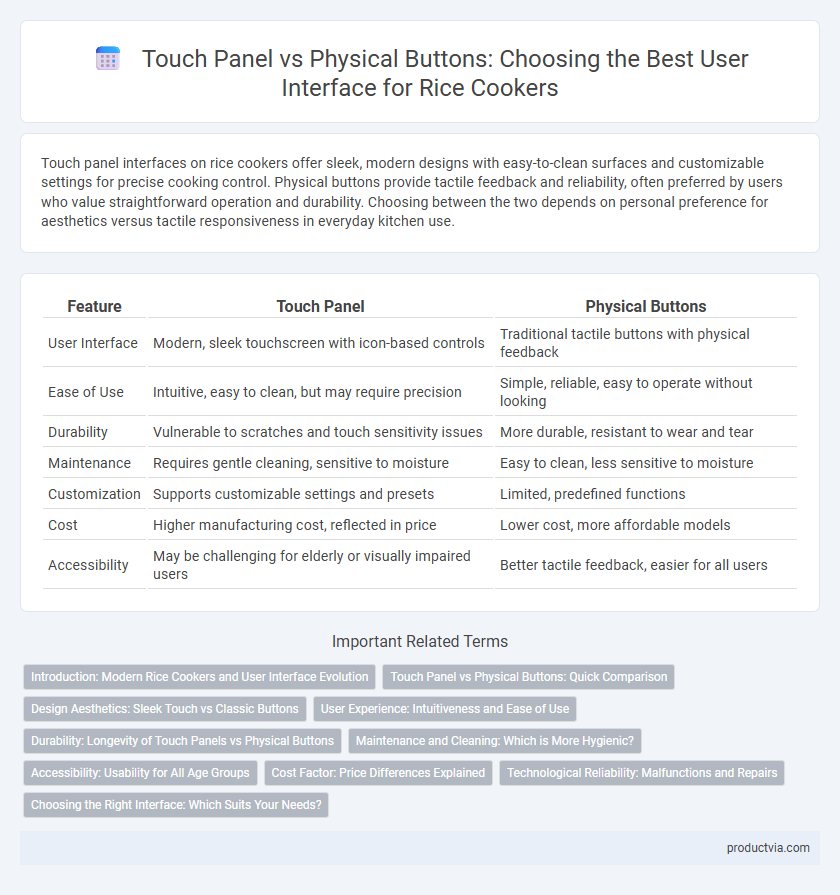Touch panel interfaces on rice cookers offer sleek, modern designs with easy-to-clean surfaces and customizable settings for precise cooking control. Physical buttons provide tactile feedback and reliability, often preferred by users who value straightforward operation and durability. Choosing between the two depends on personal preference for aesthetics versus tactile responsiveness in everyday kitchen use.
Table of Comparison
| Feature | Touch Panel | Physical Buttons |
|---|---|---|
| User Interface | Modern, sleek touchscreen with icon-based controls | Traditional tactile buttons with physical feedback |
| Ease of Use | Intuitive, easy to clean, but may require precision | Simple, reliable, easy to operate without looking |
| Durability | Vulnerable to scratches and touch sensitivity issues | More durable, resistant to wear and tear |
| Maintenance | Requires gentle cleaning, sensitive to moisture | Easy to clean, less sensitive to moisture |
| Customization | Supports customizable settings and presets | Limited, predefined functions |
| Cost | Higher manufacturing cost, reflected in price | Lower cost, more affordable models |
| Accessibility | May be challenging for elderly or visually impaired users | Better tactile feedback, easier for all users |
Introduction: Modern Rice Cookers and User Interface Evolution
Modern rice cookers have transitioned from traditional physical buttons to sleek touch panels, enhancing user experience through intuitive controls and customizable settings. Touch panels offer precise responsiveness and streamlined design, enabling easy selection of cooking modes, timers, and temperature adjustments. This evolution reflects advances in technology prioritizing convenience, durability, and modern aesthetics in kitchen appliances.
Touch Panel vs Physical Buttons: Quick Comparison
Touch panels in rice cookers offer a sleek design and ease of cleaning, while physical buttons provide tactile feedback and durability under frequent use. Touch interfaces enable customizable controls with multi-function capabilities, whereas physical buttons are less prone to unintentional activation. User preference for responsiveness and maintenance often guides the choice between touch panels and traditional physical buttons in rice cooker models.
Design Aesthetics: Sleek Touch vs Classic Buttons
Touch panel interfaces on rice cookers offer a sleek, modern design that enhances kitchen aesthetics with smooth, flat surfaces and customizable digital displays. Physical buttons provide a classic, tactile experience that appeals to users who prefer straightforward operation and visible, mechanical feedback. Choosing between these interfaces depends on whether a contemporary look or traditional usability aligns better with user preferences and kitchen decor.
User Experience: Intuitiveness and Ease of Use
Touch panels in rice cookers offer a sleek and modern interface that enhances intuitiveness by enabling direct interaction with icons and settings, making it easier for users to navigate cooking options. Physical buttons provide tactile feedback, which some users find reassuring and straightforward, reducing the chance of accidental presses and improving ease of use for those unfamiliar with digital screens. User experience is optimized by balancing the responsiveness of touch panels with the reliability of physical buttons, catering to diverse preferences and ensuring efficient operation.
Durability: Longevity of Touch Panels vs Physical Buttons
Touch panels on rice cookers offer a sleek design but may experience reduced responsiveness or wear over time due to repeated taps affecting the capacitive layer. Physical buttons generally provide greater durability, with mechanical components designed to withstand thousands of presses without performance degradation. Manufacturers often reinforce physical buttons with robust materials to ensure longevity, making them a reliable choice for long-term use in frequent cooking scenarios.
Maintenance and Cleaning: Which is More Hygienic?
Touch panels on rice cookers offer a seamless surface that is easier to wipe clean, minimizing dirt and bacteria buildup compared to physical buttons that can trap food particles and moisture in crevices. Physical buttons require more detailed cleaning tools and effort to maintain hygiene, increasing the risk of contamination over time. Maintaining a touch panel interface enhances overall cleanliness, making it the more hygienic choice for everyday rice cooker use.
Accessibility: Usability for All Age Groups
Touch panel interfaces on rice cookers offer sleek designs with customizable options but may pose challenges for elderly users or those with limited dexterity due to their sensitivity and lack of tactile feedback. Physical buttons provide clear, tactile responses that enhance accessibility, making operation easier for all age groups, especially children and seniors. Prioritizing physical buttons can improve usability across diverse users by ensuring reliable, straightforward control during cooking.
Cost Factor: Price Differences Explained
Touch panel interfaces for rice cookers generally increase manufacturing costs by 15-30% due to higher material and technology expenses compared to physical buttons. Physical buttons use simpler components such as mechanical switches, keeping the retail price of rice cookers more affordable by approximately $10-$25. Consumers focusing on budget-friendly options often prefer physical buttons, while touch panels offer a modern aesthetic at a premium price.
Technological Reliability: Malfunctions and Repairs
Touch panels in rice cookers offer sleek design but may be prone to malfunctions due to sensitivity issues or software glitches, often requiring professional repairs. Physical buttons provide greater technological reliability with fewer failures since they rely on simple mechanical switches less susceptible to electronic faults. Maintenance for physical buttons is typically straightforward and cost-effective compared to the complex diagnostics needed for touch panel repairs.
Choosing the Right Interface: Which Suits Your Needs?
Touch panels offer a sleek, modern interface with customizable options and easy cleaning, making them ideal for users who prioritize convenience and a futuristic design. Physical buttons provide tactile feedback and greater reliability, especially for users who prefer straightforward controls and durability over advanced features. Selecting the right rice cooker interface depends on personal preferences for usability, maintenance, and the desired cooking experience.
Touch Panel vs Physical Buttons for user interface Infographic

 productvia.com
productvia.com